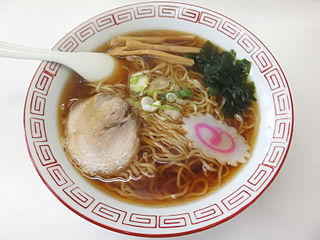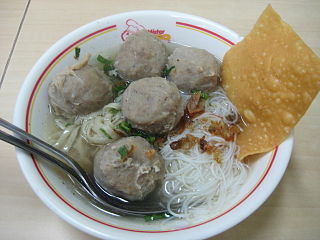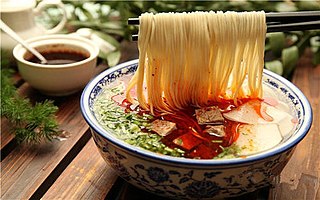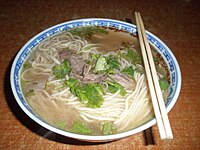
Cantonese or Guangdong cuisine, also known as Yue cuisine, is the cuisine of Guangdong province of China, particularly the provincial capital Guangzhou, and the surrounding regions in the Pearl River Delta including Hong Kong and Macau. Strictly speaking, Cantonese cuisine is the cuisine of Guangzhou or of Cantonese speakers, but it often includes the cooking styles of all the speakers of Yue Chinese languages in Guangdong.

Ramen is a Japanese noodle dish of Chinese origin. It consists of Chinese-style wheat noodles served in a broth; common flavors are soy sauce and miso, with typical toppings including sliced pork, nori, menma, and scallions. Ramen has its roots in Chinese noodle dishes and is a part of Japanese Chinese cuisine. Nearly every region in Japan has its own variation of ramen, such as the tonkotsu ramen of Kyushu and the miso ramen of Hokkaido.

Phở or Pho is a Vietnamese soup dish consisting of broth, rice noodles, herbs, and meat, sometimes chicken. Phở is a popular food in Vietnam where it is served in households, street-stalls, and restaurants country-wide. Residents of the city of Nam Định were the first to create Vietnamese traditional phở. It is considered Vietnam's national dish.

Pares, also known as beef pares, is a term for a serving of Filipino braised beef stew with garlic fried rice, and a bowl of clear soup. It is a popular food particularly associated with specialty roadside diner-style establishments known as paresan. In recent years, it had also become a common dish served in small eateries called karinderyas or carinderias that serve economical meals for locals.

Tripe soup or tripe stew is a soup or stew made with tripe. It is widely considered to be a hangover remedy.

Pancit, also spelled pansít, is a general term referring to various traditional noodle dishes in Filipino cuisine. There are numerous types of pancit, often named based on the noodles used, method of cooking, place of origin, equal and constant diameter or the ingredients. Most pancit dishes are characteristically served with calamansi, which adds a citrusy flavor profile.

Noodle soup refers to a variety of soups with noodles and other ingredients served in a light broth. Noodle soup is a common dish across East Asia, Southeast Asia and the Himalayan states of South Asia. Various types of noodles are used, such as rice noodles, wheat noodles and egg noodles.

Chinese Indonesian cuisine is characterized by the mixture of Chinese with local Indonesian style. Chinese Indonesians, mostly descendant of Han ethnic Hokkien and Hakka speakers, brought their legacy of Chinese cuisine, and modified some of the dishes with the addition of Indonesian ingredients, such as kecap manis, palm sugar, peanut sauce, chili, santan and local spices to form a hybrid Chinese-Indonesian cuisine. Some of the dishes and cakes share the same style as in Malaysia and Singapore, known as Nyonya cuisine by the Peranakan.

Korean Chinese cuisine, also known as Sino–Korean cuisine, is a hybrid cuisine developed by the ethnic Chinese in Korea.

Lamian is a type of soft wheat flour Chinese noodle that is particularly common in northern China. Lamian is made by twisting, stretching and folding the dough into strands, using the weight of the dough. The length and thickness of the strands depends on the number of times the dough is folded.

Soups in East Asian culture are eaten as one of the many main dishes in a meal or in some cases served straight with little adornment, particular attention is paid to the soups' stocks. In the case of some soups, the stock ingredients become part of the soup. They are usually based solely on broths and lacking in dairy products such as milk or cream. If thickened, the thickening usually consists of refined starches from corn or sweet potatoes.

Bakso or baso is an Indonesian meatball, or a meat paste made from beef surimi. Its texture is similar to the Chinese beef ball, fish ball, or pork ball. The word bakso may refer to a single meatball or the complete dish of meatball soup. Mie bakso refers to bakso served with yellow noodles and rice vermicelli, while bakso kuah refers to bakso soup served without noodles.

Lanzhou beef noodle soup or Lanzhou ramen is a variety of beef noodle soup. This dish has an extensive history, and the recipe differs by region due to cultural factors, availability of ingredients, and local innovations.

Hot and sour soup is a popular example of Chinese cuisine. Although it is said to be originated in Sichuan, this is actually a variant of hulatang or "pepper hot soup" (胡辣汤) with added vinegar to enhance the sourness. This variation is found in Henan province, and in Henan cuisine itself. Also popular in Southeast Asia, India, Pakistan and the United States, it is a flexible soup which allows ingredients to be substituted or added depending on availability. For example, the American-Chinese version can be thicker as it commonly includes corn starch, whilst in Japan, sake is often added.

Hot pot or hotpot, also known as steamboat, is a dish whereby a heat source placed on the dining table keeps a pot of soup stock simmering, and a variety of Chinese foodstuffs and ingredients are served beside the pot for the diners to put into the hot stock.

Hui mian is a Henan-style noodle soup. The ingredients used in the dish vary across different cities and restaurants. Typically, hui mian is made with lamb bones and a range of Chinese herbs, such as lycium chinense and star anise. However, kelp, tofu, coriander, quail eggs, chili oil, sugar, garlic, and minced peppers are also common ingredients.

Indonesian noodles are a significant aspect of Indonesian cuisine which is itself very diverse. Indonesian cuisine recognizes many types of noodles, with each region of the country often developing its own distinct recipes.

Taiwanese beef noodle soup is a beef noodle soup dish that originated in Taiwan. It is sometimes referred to as "Sichuan beef noodle soup" in Taiwan, although this usage can create confusion as Sichuan has its own versions of beef noodle soups. which may be sold at Sichuanese restaurants under the same name. The beef is often stewed with the broth and simmered, sometimes for hours. Chefs also let the stock simmer for long periods with bone marrow; some vendors can cook the beef stock for over 24 hours. In Taiwan, beef noodle vendors may also have optional, often cold side dishes, such as braised dried tofu, seaweed or pork intestine. Beef noodles are often served with suan cai on top, green onion and sometimes other vegetables in the soup as well.























